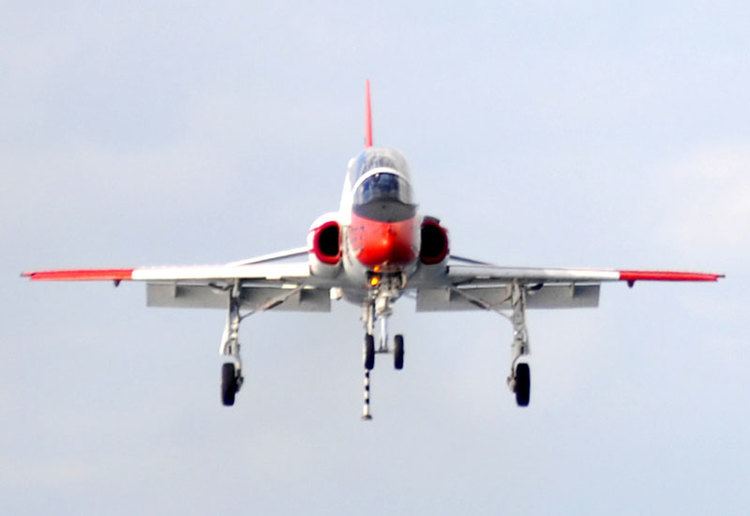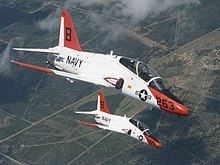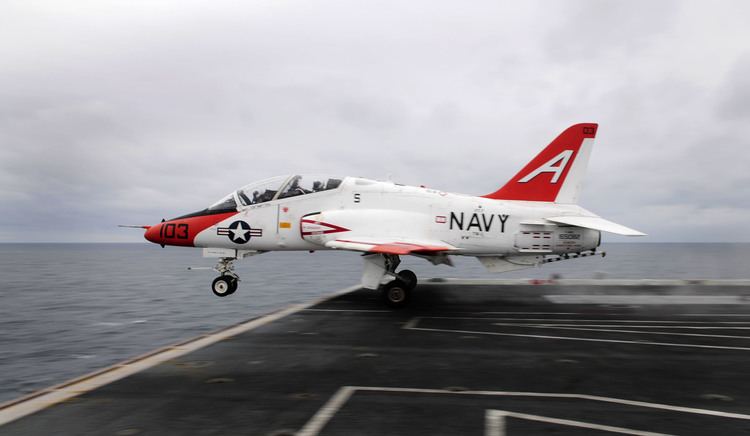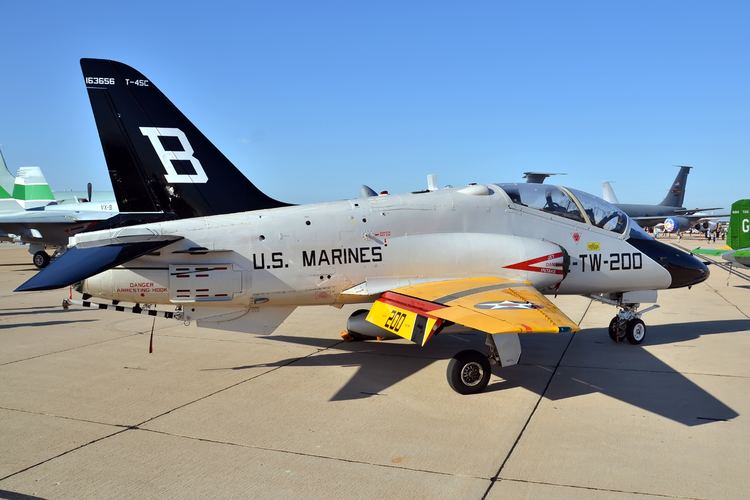Top speed 1,038 km/h Length 12 m Range 1,296 km | Weight 4,460 kg Wingspan 9.39 m Unit cost 17,200,000–17,200,000 USD | |
 | ||
Engine type Rolls-Royce Turbomeca Adour | ||
Mcdonnell douglas t 45 goshawk
The McDonnell Douglas (now Boeing) T-45 Goshawk is a highly modified version of the BAE Hawk land-based training jet aircraft. Manufactured by McDonnell Douglas (now Boeing) and British Aerospace (now BAE Systems), the T-45 is used by the United States Navy as an aircraft carrier-capable trainer.
Contents
- Mcdonnell douglas t 45 goshawk
- Design and development
- Operational history
- Variants
- Operators
- Specifications T 45A
- Avionics
- Communications suite
- References

Design and development

The T-45 Goshawk is a fully carrier-capable version of the British Aerospace Hawk Mk.60. It was developed as a jet flight trainer for the United States Navy (USN) and United States Marine Corps (USMC).

The Goshawk's origins began in the mid-1970s, when the US Navy began looking for a single aircraft replacement for both its T-2 and TA-4 jet trainers. The US Navy started the VTXTS advanced trainer program in 1978. British Aerospace (BAe) and McDonnell Douglas (MDC) proposed a version of the Hawk and were awarded the T-45 contract in 1981.

The Hawk had not been designed for carrier operations and numerous modifications were required to make it suitable for use on carriers. These included improvements to the low-speed handling characteristics and a reduction in the approach speed. It was found that the aircraft was apt to stall at the low approach speed required. Modifications were designed by BAe in England; most notably a simple slat system was devised, operated by an actuator and linkage mechanism to fit into the small space available. Strakes were also added on the fuselage to improve airflow. Other changes included a strengthened airframe, more robust and wider landing gear with catapult tow bar attachment and an arresting hook, a two-wheel nose landing gear, wing-tips squared off, 6-inch (0.152 m) extension to the tail fin, an increased span tailplane (also with squared-off tips fitted) and a single ventral fin in front of the arrestor hook.
BAE Systems manufactures the fuselage aft of the cockpit, the air inlets, the vertical stabilizer of the T-45 at Samlesbury, and the wings at Brough, England. Boeing, which merged with McDonnell Douglas in 1997, manufactures the remainder of the aircraft and assembles them in St. Louis, Missouri, after moving the program from the Long Beach, California facility.

On 16 March 2007 the 200th airframe was delivered to the US Navy. Later production aircraft were built with enhanced avionics systems for a heads up display (HUD) and glass cockpit standard, while all extant T-45A aircraft were eventually be converted to a T-45C configuration under the T-45 Required Avionics Modernization Program (T-45 RAMP), bringing all aircraft to same HUD plus glass cockpit standard. The final delivery of the 221st aircraft took place in November 2009.
Operational history
The T-45 has been used for intermediate and advanced portions of the Navy/Marine Corps Student Naval Aviator strike pilot training program with Training Air Wing One at Naval Air Station Meridian, Mississippi and Training Air Wing Two at Naval Air Station Kingsville, Texas. The T-45 replaced the T-2C Buckeye intermediate jet trainer and the TA-4J Skyhawk II advanced jet trainer with an integrated training system that includes the T-45 Goshawk aircraft, operational and instrument flight simulators (OFT/IFT), academics, and training integration system support. In 2008, the T-45C also began operation in the advanced portion of Navy/Marine Corps Student Naval Flight Officer (NFO) training track for strike aircraft with Training Air Wing Six at Naval Air Station Pensacola, Florida. A small number of the aircraft are also operated by the Naval Air Systems Command (NAVAIR) at Naval Air Station Patuxent River, Maryland.
The original T-45A, which became operational in 1991, contained an analog cockpit design while the newer T-45C, which was first delivered in December 1997, features a new digital "glass cockpit" design. All T-45A aircraft were eventually upgraded to T-45C standard are currently in operational use. The T-45 is to remain in service until 2035 or later.
Variants
Operators
Specifications (T-45A)
Data from The International Directory of Military Aircraft, 2002–2003, Navy fact file
General characteristics
Performance
Armament
Avionics
Data from naval-technology.com [1]
Communications suite
Data from naval-technology.com [4]
